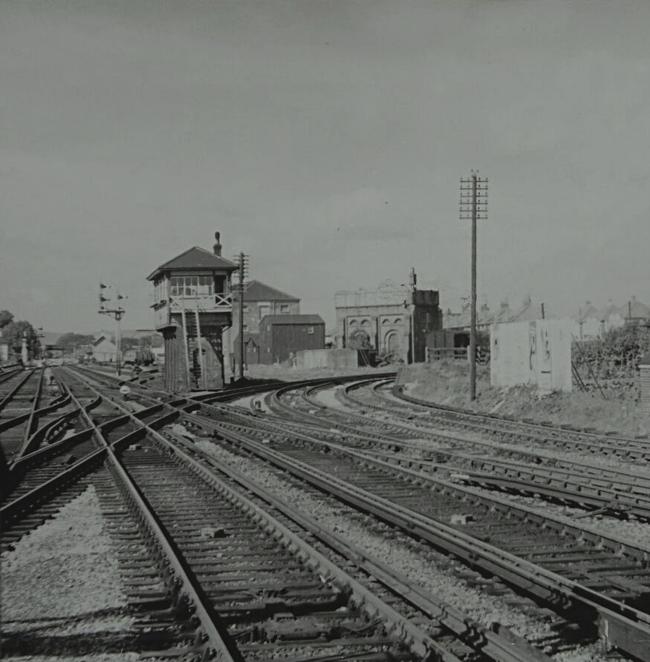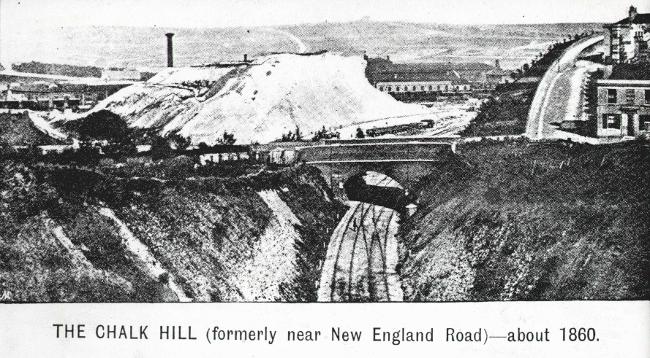
Polegate c1860-1900
Polegate Locomotive Shed was opened in c1860 by the London, Brighton & South Coast
Railway. The shed was located at the east end of Polegate Junction station (see below) in the fork of the one track straight dead-ended shed and the facilities were to include a 36ft turntable at the entrance and a water tank in the roof of the shed. The Locomotive shed was used in the early days when a single service ran both the Hailsham and Eastbourne branches.
In 1881 the length of the shed was reduced due to the realignment of the Hailsham line. The
shed was to close not long after alterations within the Polegate area.

BRIGHTON'S NEW
LOCOMOTIVE DEPOT

During 1860 - 1861. John Chester Craven, the Locomotive Superintendent of the London, Brighton, and South Coast Railway applied for planning permission to build a new locomotive shed which meant the removal of a large chalk hill to the north of the station, which had been dumped during the excavation of the main line.
The Brighton council objected to his plan and Craven's response was to relocate the Locomotive Shed and Works to Horley. The Brighton Council finally gave permission to his plans, because they did not want to loose the biggest employer in the town. The space created was used to accommodate a new much enlarged motive power depot in 1861, replacing the two existing facilities.
THREE BRIDGES LOCOMOTIVE SHED
The Second Shed
This was a two road shed affair with a slated pitched roof, the brick building from 1860 when the Horsham line was doubled. It is unclear whether this was built on the site as the original shed, but the location was one of singularity and character tucked away at a lower level on the west side of the original station, sharing space with a cramped goods yard. A glimpse down to this quaint little corner can be seen on the far left of the station-scape, the major buildings were a sawmill and an 1860s goods shed probably constructed at the same time as the brick engine shed, later this goods shed was closed as new yards were laid to the south, east and west of the Brighton main line, and it appears to have been taken over by the sawmill as photographs show it surrounded by baulks of timber. In the photograph there appears to be more sidings than shown in the ordinance survey maps, one of which on the west side with a small building near the neck is the coaling stage. The shed accommodated up to six; small locomotives, but by the turn of the century many overnighted outside or even in the small goods yard opposite especially if out of working order, amidst the most sylvan surroundings. The final addition to this cramped complex was the construction of a pump house in 1905 to replace the stationary engines. The word ‘Tank’ appears in Ordnance Survey map it was certainly not located in the roof of the engine shed. The 1897 O/S map (right) shows the three previously identified buildings adjacent to the yard sidings on the west side with the gas-works next to the river Mole.
By the turn of the century the locomotive depot had virtually taken over the former small goods yard, which had to accommodate sets of locomotives needing to reverse into the shed. Not all the facilities into this restricted hemmed in by the close proximity of the river Mole and the 45ft turntable and water tank had been located in the fork of the Brighton Horsham lines.
THREE BRIDGES LOCOMOTIVE SHED
The Second Shed
This was a two road shed affair with a slated pitched roof, the brick building from 1860 when the Horsham line was doubled. It is unclear whether this was built on the site as the original shed, but the location was one of singularity and character tucked away at a lower level on the west side of the original station, sharing space with a cramped goods yard. A glimpse down to this quaint little corner can be seen on the far left of the station-scape, the major buildings were a sawmill and an 1860s goods shed probably constructed at the same time as the brick engine shed, later this goods shed was closed as new yards were laid to the south, east and west of the Brighton main line, and it appears to have been taken over by the sawmill as photographs show it surrounded by baulks of timber. In the photograph there appears to be more sidings than shown in the ordinance survey maps, one of which on the west side with a small building near the neck is the coaling stage. The shed accommodated up to six; small locomotives, but by the turn of the century many overnighted outside or even in the small goods yard opposite especially if out of working order, amidst the most sylvan surroundings. The final addition to this cramped complex was the construction of a pump house in 1905 to replace the stationary engines. The word ‘Tank’ appears in Ordnance Survey map it was certainly not located in the roof of the engine shed. The 1897 O/S map (right) shows the three previously identified buildings adjacent to the yard sidings on the west side with the gas-works next to the river Mole.
By the turn of the century the locomotive depot had virtually taken over the former small goods yard, which had to accommodate sets of locomotives needing to reverse into the shed. Not all the facilities into this restricted hemmed in by the close proximity of the river Mole and the 45ft turntable and water tank had been located in the fork of the Brighton Horsham lines.
Railway accident on the
L.B.S.C.R.
from http://www.railwaysarchive.co.uk
Victoria 16th October 1860
no mention of Enginemen
SEE SUB PAGE